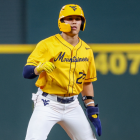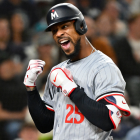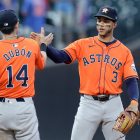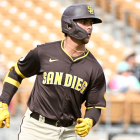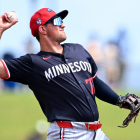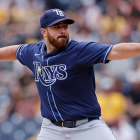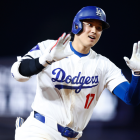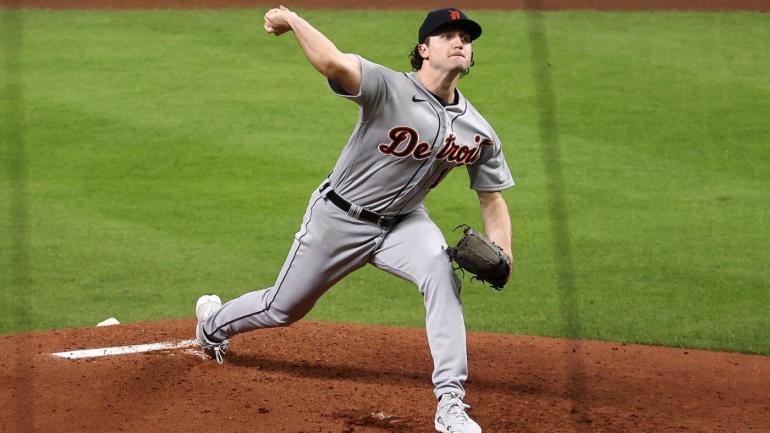
The minor-league schedule won't begin until May, but we're reviving Prospect Watch to coincide with the beginning of Major League Baseball's regular season. For those new to the feature, every Thursday we'll be highlighting something prospect-related. Sometimes it'll be spotlighting a single player, other times it'll be a trend piece; basically, whatever has caught our attention over the preceding week that can be filed, directly or indirectly, under the wide-ranging label of "prospecting."
In this Prospect Watch, we're checking in on three rookie pitchers who've had big starts to the season. Do note that the players are presented in alphabetical order.
Back in the spring we highlighted Casey Mize, the top pick in the 2019 draft, as one of several top prospects who needed to rebound after a rough introduction to the majors. So far, take number two seems to be going well for Mize, who has accumulated a 0.82 ERA and a 2.25 strikeout-to-walk ratio after shutting down the Astros for seven innings.
There's some reason to be optimistic beyond those statistics. Mize is throwing his fastball nearly two full ticks harder than he did last year; he's altered his pitch mix to better leverage his four-seamer and his splitter, as well as to incorporate a new slider/tweaked cutter that has become his most reliable secondary offering; and he's generated 20 ground balls in two outings after coercing 19 total in his final four appearances last year.
Casey Mize, Filthy 89mph Slider...and Sword. ⚔️ pic.twitter.com/XMinSDNBUJ
— Rob Friedman (@PitchingNinja) April 13, 2021
The last note is important because Mize still isn't missing bats -- to the extent that his contact rate is the second worst among the 71 qualifiers. While it would be unwise to read too much into that small sample (and it's fair to question the predictive powers of last year's numbers because of his arsenal tweaks), we now have nearly 40 innings validating the previously held belief that he'll have to manage contact to succeed.
Mize, to his credit, seems intent on providing some proof of concept that he's up to the task.
Trevor Rogers was the 13th pick in the 2017 draft (by way of the same New Mexico high school that produced Cody Ross), but it's possible that Saturday's outing against Jacob deGrom and the Mets was the biggest showcase of his career. Rogers more than held his own, recording 10 strikeouts over six shutout innings as part of a Miami victory.
Dating back to last season, Rogers has struck out nearly a third of the 170 batters he's faced in the majors. He's walked close to 12 percent of those hitters as well, meaning batted balls have been few and far between when he's been on the mound. Both of Rogers' primary pitches, a hoppy mid-90s fastball and a slider, have generated whiffs on more than half the swings taken against them in two starts this season, and he's thrown a higher than league-average amount of strikes overall despite the walk rate.
Trevor Rogers, 97mph Paint. 🖌️🎨 pic.twitter.com/FygkY09tM8
— Rob Friedman (@PitchingNinja) April 10, 2021
Take out a truly disastrous start against the Phillies last season (in which he permitted eight earned runs in three innings), and his career line would shrink to a 3.07 ERA with a 2.63 strikeout-to-walk ratio in eight starts. For reference, Rogers' now-injured and more famous teammate Sixto Sanchez finished seventh in Rookie of the Year balloting last fall after posting a 3.46 ERA and 3.00 strikeout-to-walk ratio in seven starts.
There's a lot to like here, in other words.
It's not good that the Braves are going to be without ace Mike Soroka for longer than originally expected, but Huascar Ynoa is doing his part to make Soroka's absence more tolerable. In three appearances (including two starts) so far, he's compiled 12 innings while allowing one run on six hits and two walks. He's also punched out 15 batters.
Ynoa, who was originally acquired in a forgettable 2017 trade that sent Jaime Garcia and Anthony Recker to the Twins, has found success behind what amounts to a two-pitch attack. He chucks his slider more than 45 percent of the time, yet opponents are 1 for 23 against it this season with a 44 percent whiff rate. When Ynoa wants to keep batters honest, he'll elevate his 97 mph fastball up and to the arm side.
Huascar Ynoa, Disgusting Sliders (5th, 6th and 7th Ks) pic.twitter.com/VemVIFhO1I
— Rob Friedman (@PitchingNinja) April 13, 2021
Whether or not Ynoa can make it work as a two-pitch starter for the long haul is to be determined. The inverse, complimentary spin profiles on those pitches make it difficult for batters to discern which is which until it's too late, however, and he should be able to have a career as a reliever at minimum.
















